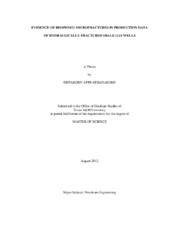| dc.contributor.advisor | Ehlig-Economides, Christine A. | |
| dc.creator | Apiwathanasorn, Sippakorn | |
| dc.date.accessioned | 2012-10-19T15:30:48Z | |
| dc.date.accessioned | 2012-10-22T18:04:11Z | |
| dc.date.available | 2014-11-03T19:49:14Z | |
| dc.date.created | 2012-08 | |
| dc.date.issued | 2012-10-19 | |
| dc.date.submitted | August 2012 | |
| dc.identifier.uri | https://hdl.handle.net/1969.1/ETD-TAMU-2012-08-11749 | |
| dc.description.abstract | Frequently a discrepancy is found between the stimulated shale volume (SSV) estimated from production data and the SSV expected from injected water and proppant volume. One possible explanation is the presence of a fracture network, often termed fracture complexity, that may have been opened or reopened during the hydraulic fracturing operation.
The main objective of this work is to investigate the role of fracture complexity in resolving the apparent SSV discrepancy and to illustrate whether the presence of reopened natural fracture network can be observed in pressure and production data of shale gas wells producing from two shale formations with different well and reservoir properties.
Homogeneous, dual porosity and triple porosity models are investigated. Sensitivity runs based on typical parameters of the Barnett and the Horn River shale are performed. Then the field data from the two shales are matched.
Homogeneous models for the two shale formations indicate effective infinite conductivity fractures in the Barnett well and only moderate conductivity fractures in the Horn River shale. Dual porosity models can support effectively infinite conductivity fractures in both shale formations.
Dual porosity models indicate that the behavior of the Barnett and Horn River shale formations are different. Even though both shales exhibit apparent bilinear flow behavior the flow behaviors during this trend are different. Evidence of this difference comes from comparing the storativity ratio observed in each case to the storativity ratio estimated from injected fluid volumes during hydraulic fracturing. In the Barnett shale case similar storativity ratios suggest fracture complexity can account for the dual porosity behavior. In the Horn River case, the model based storativity ratio is too large to represent only fluids from hydraulic fracturing and suggests presence of existing shale formation microfractures. | en |
| dc.format.mimetype | application/pdf | |
| dc.language.iso | en_US | |
| dc.subject | Production data analysis | en |
| dc.subject | Shale gas | en |
| dc.subject | Complexity | en |
| dc.subject | Reopened microfractures | en |
| dc.subject | Horn River shale | en |
| dc.subject | Barnett shale | en |
| dc.title | Evidence of Reopened Microfractures in Production Data of Hydraulically Fractured Shale Gas Wells | en |
| dc.type | Thesis | en |
| thesis.degree.department | Petroleum Engineering | en |
| thesis.degree.discipline | Petroleum Engineering | en |
| thesis.degree.grantor | Texas A&M University | en |
| thesis.degree.name | Master of Science | en |
| thesis.degree.level | Masters | en |
| dc.contributor.committeeMember | Schechter, David S. | |
| dc.contributor.committeeMember | Barrufet, Maria A. | |
| dc.type.genre | thesis | en |
| dc.type.material | text | en |
| local.embargo.terms | 2014-10-22 | |


